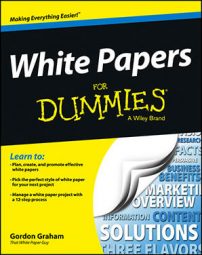A marketing team may know what a white paper looks like, they can create a mess if they don’t have experience developing effective content. Many white papers don’t turn out well, often because they weren’t planned properly from the start.
Your white paper has no call to action
The final sentence of your conclusions should be your call to action, where you outline what you want your readers to do after they finish reading. You may suggest that they find out more about what they read, continue to engage with your company, or take the next step in the buying process. Here’s an easy formula for creating a call to action:
To find out more about how [name of offering or company] can help your [business, organization, or team] [#1 benefit covered in white paper], [do something].
The more specific the action you want your readers to take, the better results you get and the easier it is to track the outcome.
One white paper can’t do it all. Ideally, a B2B vendor builds a multistep marketing campaign with all the appropriate content to draw prospects into the top of your sales funnel, nurture them through the middle, and pull them toward a sale at the bottom. The call to action in each of your white papers should urge readers to take the next step along that path.
Your white paper is a sales pitch in disguise
Publishing a thinly veiled sales pitch labeled as a white paper is the worst practice in white papers today. Some lame-brained marketers even reformat glossy brochures with a less attractive look and call them “white papers.” But this tactic is guaranteed to backfire. Every survey ever taken of B2B buyers says the same thing: White paper readers hate sales pitches. They hate any bait-and-switch games. They hate wasting their time.
An effective white paper helps a business reader understand an issue, solve a problem, or make a decision. Readers expect a white paper to provide useful information that helps them on the job. Jumping into a sales pitch irritates anyone looking for helpful, objective information.
Not enough proof in your white paper to back up claims
This problem is where many white papers fall down: Without enough solid facts to support their claims, they have no power to engage or persuade anyone about anything.
A white paper needs a good structure of supporting evidence: facts, figures, names, dates, places, statistics from impeccable sources, quotes from industry experts, and stories from happy clients. Think of this proof as the cone that gives the ice cream its support so it can stand tall.
Not enough, or not good enough, graphics in your white paper
Any white paper gains more flavor when you include at least one concept graphic to sum up its key points. You can be sure that almost every reader looks at the graphics as he scans through your document. And nearly everyone can grasp a picture faster and remember it better than text. But for many marketing people and writers, coming up with effective graphics can be tough.
You may be able to find some appropriate graphics in-house and tweak them for your purposes. Make sure to simplify lines and boxes flying off in all directions, the way most engineers sketch. And redo any tired PowerPoints.
If you can’t find what you need and you have a few dollars in your budget, you can sketch out your ideas and then give your rough sketches to a professional artist to create more finished versions.
If budget is an issue, you can find affordable photos on a site like iStockphoto, which is well indexed and overflowing with possibilities. Or try SmartDraw, the easy-to-use graphic software intended for business professionals. One final suggestion: Test out each graphic on a few people from your target audience. If they don’t understand it, go back to the drawing board for another revision.
Your white paper isn’t written by the right person
Many white papers are written by people who never asked for the job and don’t feel comfortable doing it. Sure, most product managers, developers, or salespeople can jot down a few notes for a white paper. But with no prior knowledge of what to include and what to leave out, their work will likely be incomplete and not very tasty for your B2B prospects.
Instead, find a professional writer or editor who specializes in white papers, if possible, to write, or at least review, your white paper. This person can be from your own company or from an outside firm. Your marketing team should be involved in the planning and promotion of your white paper, but not necessarily in the production.
You’re likely better served by hiring a white paper expert from outside to complete that stage, in close consultation with you. This approach can save time, money, and frustration. Sure, you may already have full-time engineers or product managers on the payroll, but surveys show that they work much slower than experienced writers, with more false starts, hesitation, and scrap.

